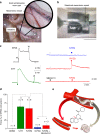The anthelmintic praziquantel is a human serotoninergic G-protein-coupled receptor ligand
- PMID: 29208933
- PMCID: PMC5716991
- DOI: 10.1038/s41467-017-02084-0
The anthelmintic praziquantel is a human serotoninergic G-protein-coupled receptor ligand
Abstract
Schistosomiasis is a debilitating tropical disease caused by infection with parasitic blood flukes. Approximately 260 million people are infected worldwide, underscoring the clinical and socioeconomic impact of this chronic infection. Schistosomiasis is treated with the drug praziquantel (PZQ), which has proved the therapeutic mainstay for over three decades of clinical use. However, the molecular target(s) of PZQ remain undefined. Here we identify a molecular target for the antischistosomal eutomer - (R)-PZQ - which functions as a partial agonist of the human serotoninergic 5HT2B receptor. (R)-PZQ modulation of serotoninergic signaling occurs over a concentration range sufficient to regulate vascular tone of the mesenteric blood vessels where the adult parasites reside within their host. These data establish (R)-PZQ as a G-protein-coupled receptor ligand and suggest that the efficacy of this clinically important anthelmintic is supported by a broad, cross species polypharmacology with PZQ modulating signaling events in both host and parasite.
Conflict of interest statement
The authors declare no competing financial interests.
Figures



Comment in
-
Praziquantel Interaction with Mammalian Targets in the Spotlight.Trends Parasitol. 2018 Apr;34(4):263-265. doi: 10.1016/j.pt.2018.01.006. Epub 2018 Feb 9. Trends Parasitol. 2018. PMID: 29433813

